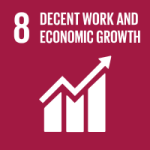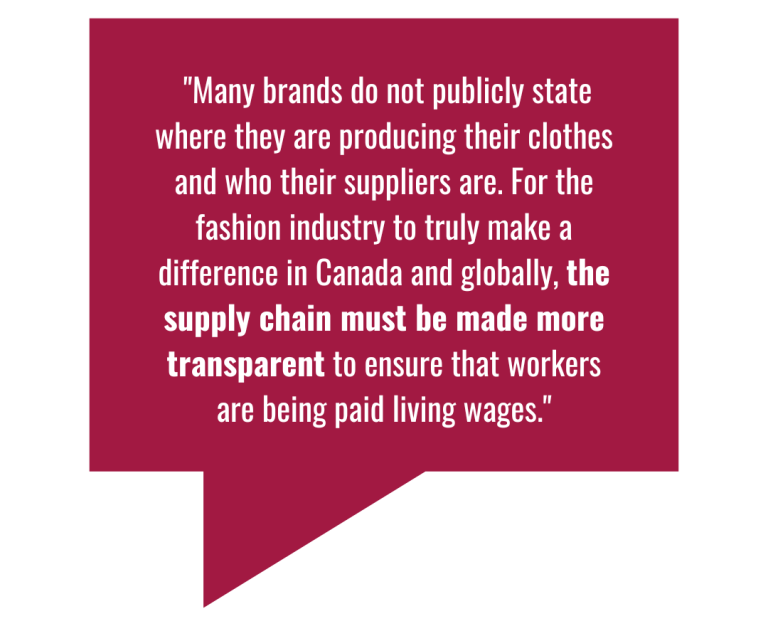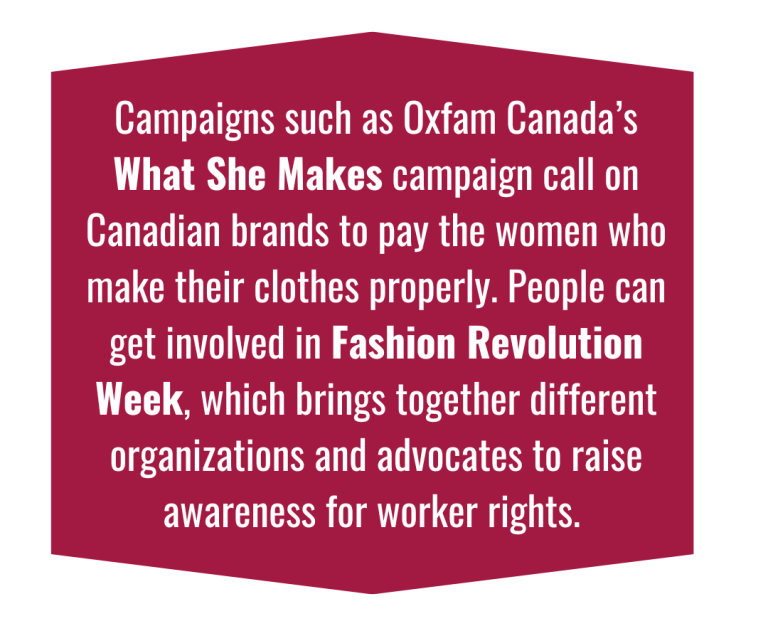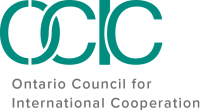
The truth behind the clothes we wear:
Why I’m an advocate for fair and equal
pay in the fashion industry

By Gladys Trinidad | June 9, 2023
Almost eight years ago, the United Nations (UN) established the Sustainable Development Goals (SDGs) in 2015. During this time all UN Member States committed to acting on these SDGs to bring “peace and prosperity for people, the planet, now and into the future.” What this means for governments, industries, and for us, the people, is to implement a strategy and put it into a call to action to come together to help the planet and the people. This includes SDG 8, which promotes sustained, inclusive and sustainable economic growth, full and productive employment and decent work for all – a guide and a push to advocating for improving the fashion and textile industry.
As someone who has previously worked in the fashion industry, it is interesting to see two sides of a luxurious and trendy lifestyle in fashion which the general public does not often get to see. Not everyone will understand the hard work, dedication and craftsmanship that the people behind a design have invested into creating something beautiful for us to wear or to even look at. For some, they are simply just clothes.
It is assumed by most people that the production of clothes is typically made in international textile factories by people who are paid below a living wage. Yet the same can be said in Toronto’s fashion industry, where many designers exploit their workers. In fact, the work put into making our clothes does not reflect the effort and labour behind it, nor how much workers are getting paid, even if produced in Canada. What kind of reward do designers offer these workers? Experience that is hardly recognized and the opportunity to meet new fashion friends along the way. Even though this was told to me by a former designer boss as career advice, this is insufficient to sustain a life when you are being paid unjustly for the hours you work.
I began my fashion and design journey right after high school. Working as a design assistant at that time, I was thrilled to learn from amazing people and assumed that working for a designer for $50 a day was the norm in this industry. Despite the hardships and feeling devalued by my work, I am grateful for all the seamstresses, designers, pattern makers, fabric cutters, and everyone I have met in my fashion journey. Without them, I would not have honed the skills I have now. But over time I began to feel that working for low wages, without recognition, should not be the norm. For this reason, I felt it was necessary to make a difference within the fashion industry.
Since working with this amount of talent in Toronto, I find myself changing my passion from design to advocating for workers’ rights and decent work within the fashion and textile industry, both for Canadian and international textile workers.

Based on my experience, one of the companies I worked for paid minimum wage and included piece rates, meaning being paid per unit, instead of the time spent on the job. This does not make up for living costs considering most workers who I have met while working in fashion who are hired to work in production are immigrants, have families, or are in a vulnerable situation. The number of clothes these companies expect garment workers to produce is unrealistic, so companies can employ hundreds of people to produce at a fast rate.
SDG 8 focuses on ensuring sustainable economic growth for everyone, which means ensuring safe and fair labour conditions for all workers. This includes the fashion industry, where 50,000 are employed in Toronto while globally, more than 300 million people work along the value chain which includes design, distribution and retail. Seamstresses are forced to work long hours doing repetitive work, sitting for long periods, often resulting in wrist and hand injuries. Also, considering the number of fabric rolls and cutters that are not being safely guarded and are potential risks to their workers. The fashion industry’s exploitation of workers concerning their living wages and unsafe working conditions is in need of change.
A series of high-profile cases of unfair treatment, including but not limited to low wages, abuse, and unsafe working conditions over the last decade resulted in both global and domestic responses to this issue which SDG 8 looks to address. According to Fashion Takes Action (2023), garment workers experience dangerous working conditions, workplace discrimination and exploitation at all levels of the fashion industry. As such, fashion companies need to develop policies that adhere to universal human rights, which they should all follow.

Brands such as Joe Fresh, Aritzia or Roots have incredible power and money and profit from exploiting garment workers by producing their clothes through facilities that pay low wages. These factories do not have adequate policies to ensure the safety and fair treatment of workers and to uphold environmental standards.
However, many brands do not publicly state where they are producing their clothes and who their suppliers are. For the fashion industry to truly make a difference in Canada and globally, the supply chain must be made more transparent to ensure that workers are being paid living wages. Oxfam Canada (2022) explains further that company disclosure allows the public to know from where they are sourcing and who are producing their clothes. Supply chain transparency also allows anyone to know who their favourite companies’ suppliers are and to monitor what policies are being implemented in these workplaces to ensure workers are being treated fairly and are paid a living wage.
How can we help if brands refuse to disclose their suppliers? Although SDG 8 promotes decent work and economic growth, it also addresses how we have the right to demand changes in our wages and living standards, which are those involved with reforming the fashion industry and the differences in wealth between garment workers and the owners of these big brands.
Some movements in Canada and globally are working towards improving the working conditions in the fashion and textile industry that anyone can join. Campaigns such as Oxfam Canada’s What She Makes campaign call on Canadian brands to pay the women who make their clothes properly. People can get involved in Fashion Revolution Week, which brings together different organizations and advocates to raise awareness for worker rights.
Reflecting on my experience in the industry I am reminded of the people I have met along the way who deserve proper living wages to sustain themselves and their families. As for someone like me who is interested in policy, I will continue to advocate for progressive changes in the policies for fair trade and protection of workers in the fashion industry, and invite you to learn more and support the cause.
With a background in Fashion Design and Content Creation, Gladys is passionate about sustainability, climate change and workers and women’s rights, specifically within the fashion and textile industry. Her work and personal experiences inspired her to go back to school for International Development. She also has experience working in communications, which has allowed her to use both her creativity and passion to advocate and share information on various social media platforms to magnify global issues and influence online communities. She truly believes that online tools hold incredible power in this generation. With her passion in fashion, development and content creation, she hopes to amplify voices and create a safer environment for workers in a more sustainable and ethical future in the fashion industry.







